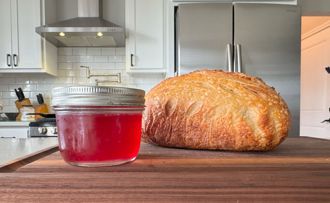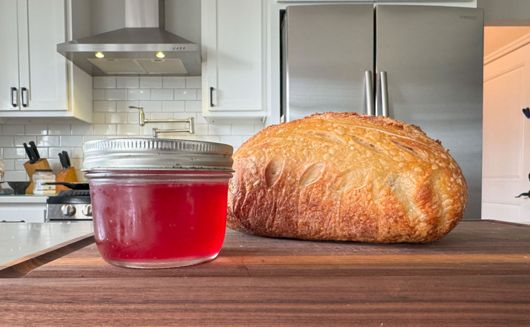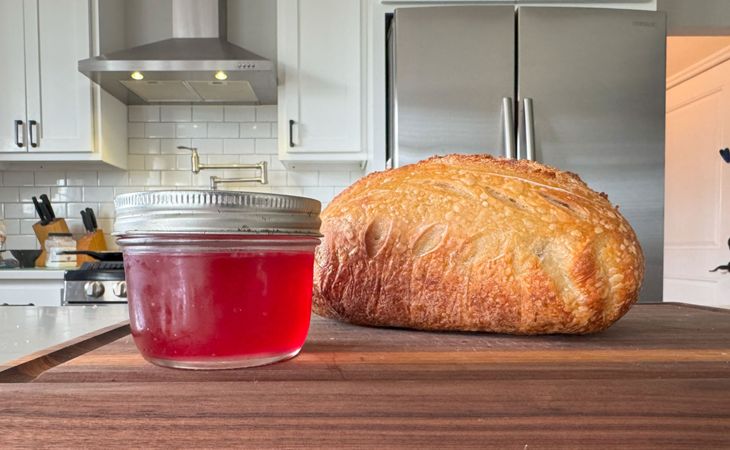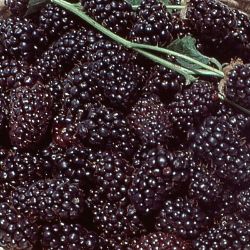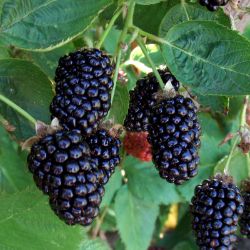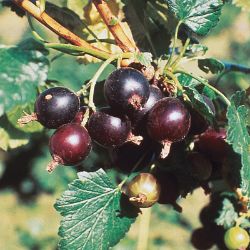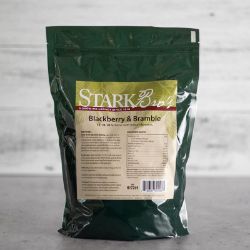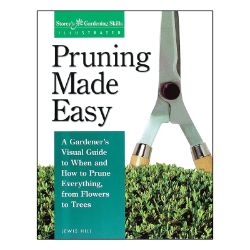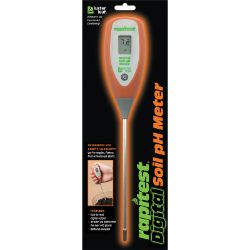Pest & Disease Control for Hybrid Berry Plants
Every plant has the future potential for disease and insect damage. Factors such as location and weather will play a part in which issues your plants encounters. If available, disease-resistant varieties are the best option for easy care; and for all types of plants, proper maintenance (such as watering, pruning, spraying, weeding, and cleanup) can help keep most insects and diseases at bay.
NOTE: This is part 7 in a series of 11 articles. For a complete background on how to grow hybrid berry plants, we recommend starting from the beginning.
Crown Gall
Plants appear stunted and slow growing. Leaves may be reduced in size, little or no fruit. If plant is dead, inspect roots for hard, woody tumors. Note: many things can cause stunted plants.
Natural Control
- Do not plant berries in beds where they have previously grown and died for no apparent reason.
Other Control Options
- Consult County Extension Agent
Aphids
They are the size of a pinhead and vary in color depending on the species. Cluster on stems and under leaves, sucking plant juices. Leaves then curl, thicken, yellow and die. Produce large amounts of a liquid waste called “honeydew”. Aphid sticky residue becomes a growth media for sooty mold.
Control
- Consult County Extension Agent
Cane Borer
Adult is long-horned beetle. Larvae indicated by sawdust.
Natural Control
- Cut out infected cane until larvae is found and destroy.
Other Control Options
- Consult County Extension Agent
Cane Blight
Enters through wounds made by insects or mechanically. Cause large brown dead areas (cankers). Often first noticed when leaves wilt and wither. Cut back to below cankers; disinfect shears between cuts with 1 part bleach and 10-part water solution. Dispose of pruning.
Control
- Consult County Extension Agent
Spot Anthracnose
This disease is more common on black raspberry. Area appears reddish-brown sunken spots with purple margins and light gray centers on young shoots. Grow together into cankers. Leaves may drop early. Fruit may dry up. Over winters in lesions on old canes. Always remove and burn old fruiting canes after harvest.
Natural Control
- Proper prune and weed control.
- Always remove and burn old fruiting canes after harvest.
Other Control Options
- Consult County Extension Agent
Orange Rust
Not common on red raspberry but serious on all others, especially blackberries. Underside of leaves covered with orange-yellow spores.
Natural Control
- Remove infected plants.
Other Control Options
- Consult County Extension Agent
Fruit Rot
Appears as gray, hairy mold. Decays blossoms, green and ripening fruits and harvested fruits.
Control
- Consult County Extension Agent
Powdery Mildew
Whitish-gray powdery mold or felt-like patches on leaves and green twigs. Leaves may crinkle and cup upward. Over winters in fallen leaves.
Natural Control
- Fall clean up of debris.
Other Control Options
- Consult County Extension Agent
Fruitworm
Adult is yellow to brown sawfly beetle, 1/4” long. Larvae are brown and white, 1/8” long. Adult make slits in flower buds and larvae feed on berries.
Control
- Consult County Extension Agent
Mites
Pinpoint size, many different colors. Found on undersides of leaves. Severe infestations have some silken webbing. Sap feeding causes bronzing of leaves.
Control
- Consult County Extension Agent
Japanese Beetle
Adult is metallic green beetle. Skeletonizes leaves. Larvae are a grub, which feeds on turf roots. This is more of a problem east of the Mississippi River.
Control
- Consult County Extension Agent
Leaf Curl
Leaves thicken and curl much like they have aphids. Spread by insects usually from June until plants ready to cultivate. This is caused by a virus and spread partially by Raspberry Aphid, which is hard to control.
Natural Control
- Remove and burn dead canes.
- Remove wild berries from area.
Other Control Options
- Consult County Extension Agent
Mosiac
Leaves will thicken and curl, display ‘mottled’ color. There will be dark green areas and bright green areas on same leaf. Caused by a virus and spread partially by Raspberry Aphid which is hard to control.
Natural Control
- Remove and burn dead canes.
- Remove wild berries from area.
Other Control Options
- Consult County Extension Agent
Every plant has the future potential for disease and insect damage. Factors such as location and weather will play a part in which issues your plants encounters. If available, disease-resistant varieties are the best option for easy care; and for all types of plants, proper maintenance (such as watering, pruning, spraying, weeding, and cleanup) can help keep most insects and diseases at bay.
Verticullium Wilt
Infected areas will have yellowing foliage, slowed growth, large seed production and death of branches. New canes will often wilt.
Natural Control
- Plant only certified berries, destroy infected plants, DO NOT plant in same location.
- Plant should receive plenty of water to promote growth and avoid stress.
Other Control Options
- Consult County Extension Agent
Powdery Mildew
Whitish-gray powdery mold or felt like patches on leaves and green twigs. Leaves may crinkle and curl upward. Over winters in fallen leaves.
Control
- Consult County Extension Agent
Crown and Cane Gall
Plants appear stunted and slow growing, leaves may be reduced in size, little or no fruit. If plant is dead, inspect roots for hard, woody tumors. Note: many things can cause stunted plants.
Control
- Consult County Extension Agent
Leafhopper
Small, active, slender-winged insects, various colors, usually found on underside of leaves, similar to aphids. Retard growth, leaves become whitened, stippled or mottled. Tips may wither and die. This insect carries virus of certain very harmful plant diseases.
Control
- Consult County Extension Agent
Cutworm
Large (vary from ½ -2” long) fleshy, hairless caterpillars. Adult cutworms are dark, night flying moths with bands or stripes on their forewings and lighter color hind wings. Some feed on the stems, others feed on new tender growth. Cutworms feed at night and can destroy a new plant over night.
Control
- Consult County Extension Agent
Armyworm
Newly hatched worms are white with black heads. Mature worms are light tan or dark brown with dark or orange back and side stripes. The feed on the leaves of plants.
Natural Control
- Hi-Yield® Vegetable & Ornamental Insect Control
Aphids
They are the size of a pinhead and vary in color depending on the species. Cluster on stems and under leaves, sucking plant juices. Leaves then curl, thicken, yellow and die. Produce large amounts of a liquid water called “honeydew”. Aphid sticky residue becomes growth media for sooty mold.
Control
- Consult County Extension Agent
Mites
Pinpoint size, many different colors. Found on undersides of leaves. Severe infestations have some silken webbing. Sap feeding causes bronzing of leaves.
Control
- Consult County Extension Agent
Leafroller
Pale yellow or ‘dirty’ green worms. Leaves are rolled and webbed together where insects feed. Eventually becomes ‘skeletonized’.
Natural Control
- Hi-Yield® Vegetable & Ornamental Insect Control
Leaf and Cane Spot
Small red-bordered spots appear on new leaves, canes and occasionally on fruit. These spots will grow and eventually the infected piece will fall out, leaving a hole in the leaf.
Natural Control
- Destroy infected leaves and canes.
Other Control Options
- Consult County Extension Agent
Orange Rust
Leaves are dwarfed and undersides covered with large powdery masses of orange colored spores. Young shoots appear spindly and elongated.
Natural Control
- Affected plants should be destroyed as soon as possible.
Other Control Options
- Consult County Extension Agent
Every plant has the future potential for disease and insect damage. Factors such as location and weather will play a part in which issues your plants encounters. If available, disease-resistant varieties are the best option for easy care; and for all types of plants, proper maintenance (such as watering, pruning, spraying, weeding, and cleanup) can help keep most insects and diseases at bay.
Leafroller
Pale yellow or ‘dirty’ green worms. Leaves are rolled and webbed together where insects feed. Eventually becomes ‘skeletonized’.
Control
- Consult County Extension Agent
Blackvine Weevils
Adults are 3/8" long, oblong-shaped, with a short snout; dull, slate gray to brownish-black color C-shaped larvae are cream colored with shiny brown heads adult weevils feed on foliage more serious damage is done by grubs (larval stage), which feed on the roots and may girdle the main stem often killing the plant.
Control
- Consult County Extension Agent
Raspberry Crown Borer
Adult moth resembles a yellow jacket wasp, lays reddish brown eggs. Once hatched, larva migrates to the base of the plant. They will dig into the base of cane and then continue in the roots and crown. There will be a hole at the base of the plant in the crown with sawdust like frass. Plant will begin to wither and visibly wilt due to tissue damage.
Natural Control
- Remove and destroy all infested plants.
Other Control Options
- Consult County Extension Agent
Spider Mites
Pinpoint size, many different colors. Found on undersides of leaves. Severe infestations have some silken webbing. Sap feeding causes bronzing of leaves.
Control
- Consult County Extension Agent
Aphids
They are the size of a pinhead and vary in color depending on the species. Cluster on stems and under leaves, sucking plant juices. Leaves then curl, thicken, yellow and die. Produce large amounts of a liquid waste called “honeydew”. Aphid sticky residue becomes growth media for sooty mold.
Control
- Consult County Extension Agent
Crown and Cane Gall
Plants appear stunted and slow growing. Leaves may be reduced in size, little or no fruit. If plant is dead, inspect roots for hard, woody tumors. Note: many things can cause stunted plants. Appearance of round galls on stems and roots near the soil surface, young galls are small and whitish, older galls are black-brown and may girdle the stem.
Control
- Consult County Extension Agent
Root Rot
Poorly drained soil, wet soil should be well tilled with organic matter prior to planting. Plants become unthrifty. Leaves may turn yellow to red and collapse. The crowns, when sectioned, exhibit a brown-black decay. Large roots lack small feeder roots. Larger roots may have large brown-black lesions present.
Control
- Consult County Extension Agent
Veticillium Wilt
Infected areas will have yellowing foliage, slowed growth, large seed production and death of branches. New canes will often wilt.
Natural Control
- Plant only certified berries.
- Destroy infected plants, DO NOT plant in same location.
- Plant should receive plenty of water to promote growth and avoid stress.
Other Control Options
- Consult County Extension Agent

